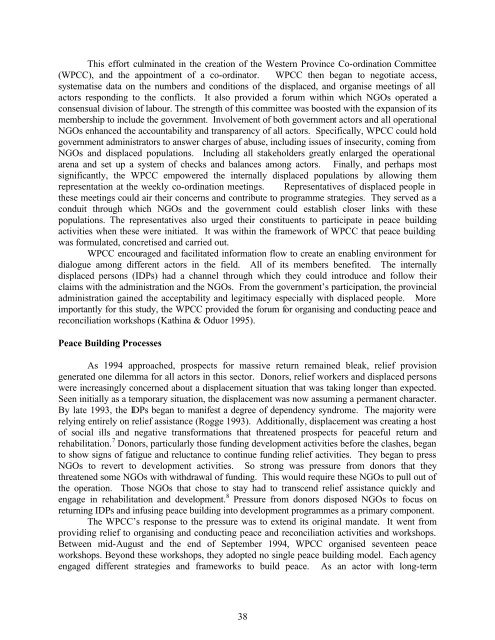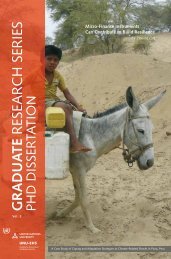Unveiling Women as Pillars of Peace Peace Building in ...
Unveiling Women as Pillars of Peace Peace Building in ...
Unveiling Women as Pillars of Peace Peace Building in ...
You also want an ePaper? Increase the reach of your titles
YUMPU automatically turns print PDFs into web optimized ePapers that Google loves.
This effort culm<strong>in</strong>ated <strong>in</strong> the creation <strong>of</strong> the Western Prov<strong>in</strong>ce Co-ord<strong>in</strong>ation Committee<br />
(WPCC), and the appo<strong>in</strong>tment <strong>of</strong> a co-ord<strong>in</strong>ator. WPCC then began to negotiate access,<br />
systematise data on the numbers and conditions <strong>of</strong> the displaced, and organise meet<strong>in</strong>gs <strong>of</strong> all<br />
actors respond<strong>in</strong>g to the conflicts. It also provided a forum with<strong>in</strong> which NGOs operated a<br />
consensual division <strong>of</strong> labour. The strength <strong>of</strong> this committee w<strong>as</strong> boosted with the expansion <strong>of</strong> its<br />
membership to <strong>in</strong>clude the government. Involvement <strong>of</strong> both government actors and all operational<br />
NGOs enhanced the accountability and transparency <strong>of</strong> all actors. Specifically, WPCC could hold<br />
government adm<strong>in</strong>istrators to answer charges <strong>of</strong> abuse, <strong>in</strong>clud<strong>in</strong>g issues <strong>of</strong> <strong>in</strong>security, com<strong>in</strong>g from<br />
NGOs and displaced populations. Includ<strong>in</strong>g all stakeholders greatly enlarged the operational<br />
arena and set up a system <strong>of</strong> checks and balances among actors. F<strong>in</strong>ally, and perhaps most<br />
significantly, the WPCC empowered the <strong>in</strong>ternally displaced populations by allow<strong>in</strong>g them<br />
representation at the weekly co-ord<strong>in</strong>ation meet<strong>in</strong>gs. Representatives <strong>of</strong> displaced people <strong>in</strong><br />
these meet<strong>in</strong>gs could air their concerns and contribute to programme strategies. They served <strong>as</strong> a<br />
conduit through which NGOs and the government could establish closer l<strong>in</strong>ks with these<br />
populations. The representatives also urged their constituents to participate <strong>in</strong> peace build<strong>in</strong>g<br />
activities when these were <strong>in</strong>itiated. It w<strong>as</strong> with<strong>in</strong> the framework <strong>of</strong> WPCC that peace build<strong>in</strong>g<br />
w<strong>as</strong> formulated, concretised and carried out.<br />
WPCC encouraged and facilitated <strong>in</strong>formation flow to create an enabl<strong>in</strong>g environment for<br />
dialogue among different actors <strong>in</strong> the field. All <strong>of</strong> its members benefited. The <strong>in</strong>ternally<br />
displaced persons (IDPs) had a channel through which they could <strong>in</strong>troduce and follow their<br />
claims with the adm<strong>in</strong>istration and the NGOs. From the government’s participation, the prov<strong>in</strong>cial<br />
adm<strong>in</strong>istration ga<strong>in</strong>ed the acceptability and legitimacy especially with displaced people. More<br />
importantly for this study, the WPCC provided the forum for organis<strong>in</strong>g and conduct<strong>in</strong>g peace and<br />
reconciliation workshops (Kath<strong>in</strong>a & Oduor 1995).<br />
<strong>Peace</strong> <strong>Build<strong>in</strong>g</strong> Processes<br />
As 1994 approached, prospects for m<strong>as</strong>sive return rema<strong>in</strong>ed bleak, relief provision<br />
generated one dilemma for all actors <strong>in</strong> this sector. Donors, relief workers and displaced persons<br />
were <strong>in</strong>cre<strong>as</strong><strong>in</strong>gly concerned about a displacement situation that w<strong>as</strong> tak<strong>in</strong>g longer than expected.<br />
Seen <strong>in</strong>itially <strong>as</strong> a temporary situation, the displacement w<strong>as</strong> now <strong>as</strong>sum<strong>in</strong>g a permanent character.<br />
By late 1993, the IDPs began to manifest a degree <strong>of</strong> dependency syndrome. The majority were<br />
rely<strong>in</strong>g entirely on relief <strong>as</strong>sistance (Rogge 1993). Additionally, displacement w<strong>as</strong> creat<strong>in</strong>g a host<br />
<strong>of</strong> social ills and negative transformations that threatened prospects for peaceful return and<br />
rehabilitation. 7 Donors, particularly those fund<strong>in</strong>g development activities before the cl<strong>as</strong>hes, began<br />
to show signs <strong>of</strong> fatigue and reluctance to cont<strong>in</strong>ue fund<strong>in</strong>g relief activities. They began to press<br />
NGOs to revert to development activities. So strong w<strong>as</strong> pressure from donors that they<br />
threatened some NGOs with withdrawal <strong>of</strong> fund<strong>in</strong>g. This would require these NGOs to pull out <strong>of</strong><br />
the operation. Those NGOs that chose to stay had to transcend relief <strong>as</strong>sistance quickly and<br />
engage <strong>in</strong> rehabilitation and development. 8 Pressure from donors disposed NGOs to focus on<br />
return<strong>in</strong>g IDPs and <strong>in</strong>fus<strong>in</strong>g peace build<strong>in</strong>g <strong>in</strong>to development programmes <strong>as</strong> a primary component.<br />
The WPCC’s response to the pressure w<strong>as</strong> to extend its orig<strong>in</strong>al mandate. It went from<br />
provid<strong>in</strong>g relief to organis<strong>in</strong>g and conduct<strong>in</strong>g peace and reconciliation activities and workshops.<br />
Between mid-August and the end <strong>of</strong> September 1994, WPCC organised seventeen peace<br />
workshops. Beyond these workshops, they adopted no s<strong>in</strong>gle peace build<strong>in</strong>g model. Each agency<br />
engaged different strategies and frameworks to build peace. As an actor with long-term<br />
38



